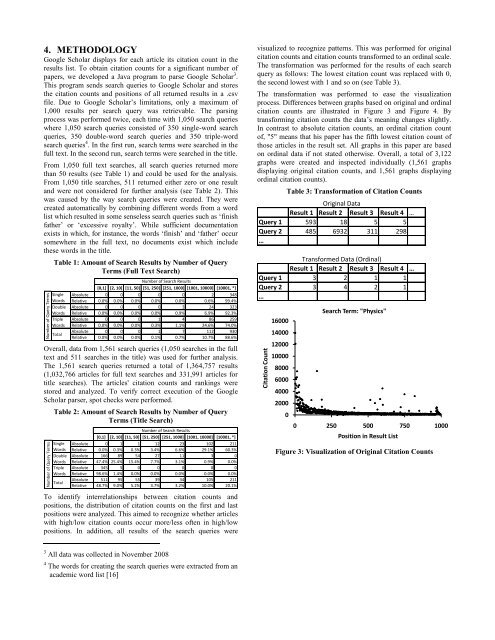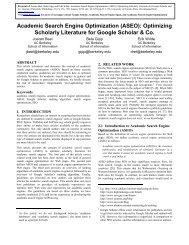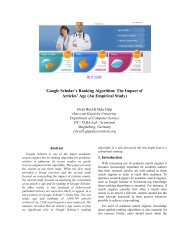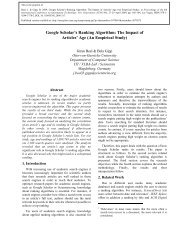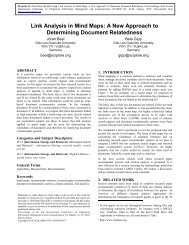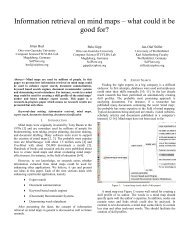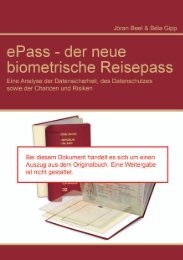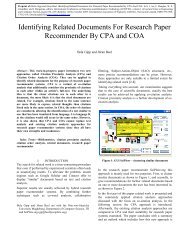Google Scholar's Ranking Algorithm: The Impact of ... - Bela Gipp
Google Scholar's Ranking Algorithm: The Impact of ... - Bela Gipp
Google Scholar's Ranking Algorithm: The Impact of ... - Bela Gipp
Create successful ePaper yourself
Turn your PDF publications into a flip-book with our unique Google optimized e-Paper software.
Number <strong>of</strong> Query TermsCitation CountNumber <strong>of</strong> Query Terms4. METHODOLOGY<strong>Google</strong> Scholar displays for each article its citation count in theresults list. To obtain citation counts for a significant number <strong>of</strong>papers, we developed a Java program to parse <strong>Google</strong> Scholar 3 .This program sends search queries to <strong>Google</strong> Scholar and storesthe citation counts and positions <strong>of</strong> all returned results in a .csvfile. Due to <strong>Google</strong> Scholar‟s limitations, only a maximum <strong>of</strong>1,000 results per search query was retrievable. <strong>The</strong> parsingprocess was performed twice, each time with 1,050 search querieswhere 1,050 search queries consisted <strong>of</strong> 350 single-word searchqueries, 350 double-word search queries and 350 triple-wordsearch queries 4 . In the first run, search terms were searched in thefull text. In the second run, search terms were searched in the title.From 1,050 full text searches, all search queries returned morethan 50 results (see Table 1) and could be used for the analysis.From 1,050 title searches, 511 returned either zero or one resultand were not considered for further analysis (see Table 2). Thiswas caused by the way search queries were created. <strong>The</strong>y werecreated automatically by combining different words from a wordlist which resulted in some senseless search queries such as „finishfather‟ or „excessive royalty‟. While sufficient documentationexists in which, for instance, the words „finish‟ and „father‟ occursomewhere in the full text, no documents exist which includethese words in the title.Table 1: Amount <strong>of</strong> Search Results by Number <strong>of</strong> QueryTerms (Full Text Search)SingleWordsDoubleWordsTripleWordsTotalNumber <strong>of</strong> Search Results[0,1] [2, 10] [11, 50] [51, 250] [251, 1000] [1001, 10000] [10001, *]Absolute 0 0 0 0 0 2 348Relative 0.0% 0.0% 0.0% 0.0% 0.0% 0.6% 99.4%Absolute 0 0 0 0 3 24 323Relative 0.0% 0.0% 0.0% 0.0% 0.9% 6.9% 92.3%Absolute 0 0 0 1 4 86 259Relative 0.0% 0.0% 0.0% 0.3% 1.1% 24.6% 74.0%Absolute 0 0 0 1 7 112 930Relative 0.0% 0.0% 0.0% 0.1% 0.7% 10.7% 88.6%Overall, data from 1,561 search queries (1,050 searches in the fulltext and 511 searches in the title) was used for further analysis.<strong>The</strong> 1,561 search queries returned a total <strong>of</strong> 1,364,757 results(1,032,766 articles for full text searches and 331,991 articles fortitle searches). <strong>The</strong> articles' citation counts and rankings werestored and analyzed. To verify correct execution <strong>of</strong> the <strong>Google</strong>Scholar parser, spot checks were performed.Table 2: Amount <strong>of</strong> Search Results by Number <strong>of</strong> QueryTerms (Title Search)SingleWordsDoubleWordsTripleWordsTotalNumber <strong>of</strong> Search Results[0,1] [2, 10] [11, 50] [51, 250] [251, 1000] [1001, 10000] [10001, *]Absolute 0 1 1 12 23 102 211Relative 0.0% 0.3% 0.3% 3.4% 6.6% 29.1% 60.3%Absolute 166 89 54 27 11 3 0Relative 47.4% 25.4% 15.4% 7.7% 3.1% 0.9% 0.0%Absolute 345 5 0 0 0 0 0Relative 98.6% 1.4% 0.0% 0.0% 0.0% 0.0% 0.0%Absolute 511 95 55 39 34 105 211Relative 48.7% 9.0% 5.2% 3.7% 3.2% 10.0% 20.1%To identify interrelationships between citation counts andpositions, the distribution <strong>of</strong> citation counts on the first and lastpositions were analyzed. This aimed to recognize whether articleswith high/low citation counts occur more/less <strong>of</strong>ten in high/lowpositions. In addition, all results <strong>of</strong> the search queries werevisualized to recognize patterns. This was performed for originalcitation counts and citation counts transformed to an ordinal scale.<strong>The</strong> transformation was performed for the results <strong>of</strong> each searchquery as follows: <strong>The</strong> lowest citation count was replaced with 0,the second lowest with 1 and so on (see Table 3).<strong>The</strong> transformation was performed to ease the visualizationprocess. Differences between graphs based on original and ordinalcitation counts are illustrated in Figure 3 and Figure 4. Bytransforming citation counts the data‟s meaning changes slightly.In contrast to absolute citation counts, an ordinal citation count<strong>of</strong>, "5" means that his paper has the fifth lowest citation count <strong>of</strong>those articles in the result set. All graphs in this paper are basedon ordinal data if not stated otherwise. Overall, a total <strong>of</strong> 3,122graphs were created and inspected individually (1,561 graphsdisplaying original citation counts, and 1,561 graphs displayingordinal citation counts).Table 3: Transformation <strong>of</strong> Citation CountsOriginal DataResult 1 Result 2 Result 3 Result 4 …Query 1 593 18 5 5Query 2 485 6932 311 298…Transformed Data (Ordinal)Result 1 Result 2 Result 3 Result 4 …Query 1 3 2 1 1Query 2 3 4 2 1…1600014000120001000080006000400020000Search Term: "Physics"0 250 500 750 1000Position in Result ListFigure 3: Visualization <strong>of</strong> Original Citation Counts3 All data was collected in November 20084 <strong>The</strong> words for creating the search queries were extracted from anacademic word list [16]


